Operations & Project Management: Review & Critique of TESCO Practices
VerifiedAdded on 2023/06/16
|30
|7642
|305
Report
AI Summary
This report provides a comprehensive review of TESCO's operations management practices, comparing operations and operations management, and critically evaluating the adoption of operations management principles within the company. It analyzes how well the firm's operations management fulfills its needs, explains continuous improvement in relation to lean principles, and prepares a continuous improvement plan with suggestions and justifications. The report covers lean production, mass communication, and agile manufacturing, assessing their pros and cons in the context of TESCO. Furthermore, it delves into lean principles such as identifying worth, creating value stream maps, building flow, establishing pull, and pursuing perfection, alongside Six Sigma methodologies and Kaizen principles, ultimately forming a course of action for continuous improvement based on a critical evaluation of operations management principles.
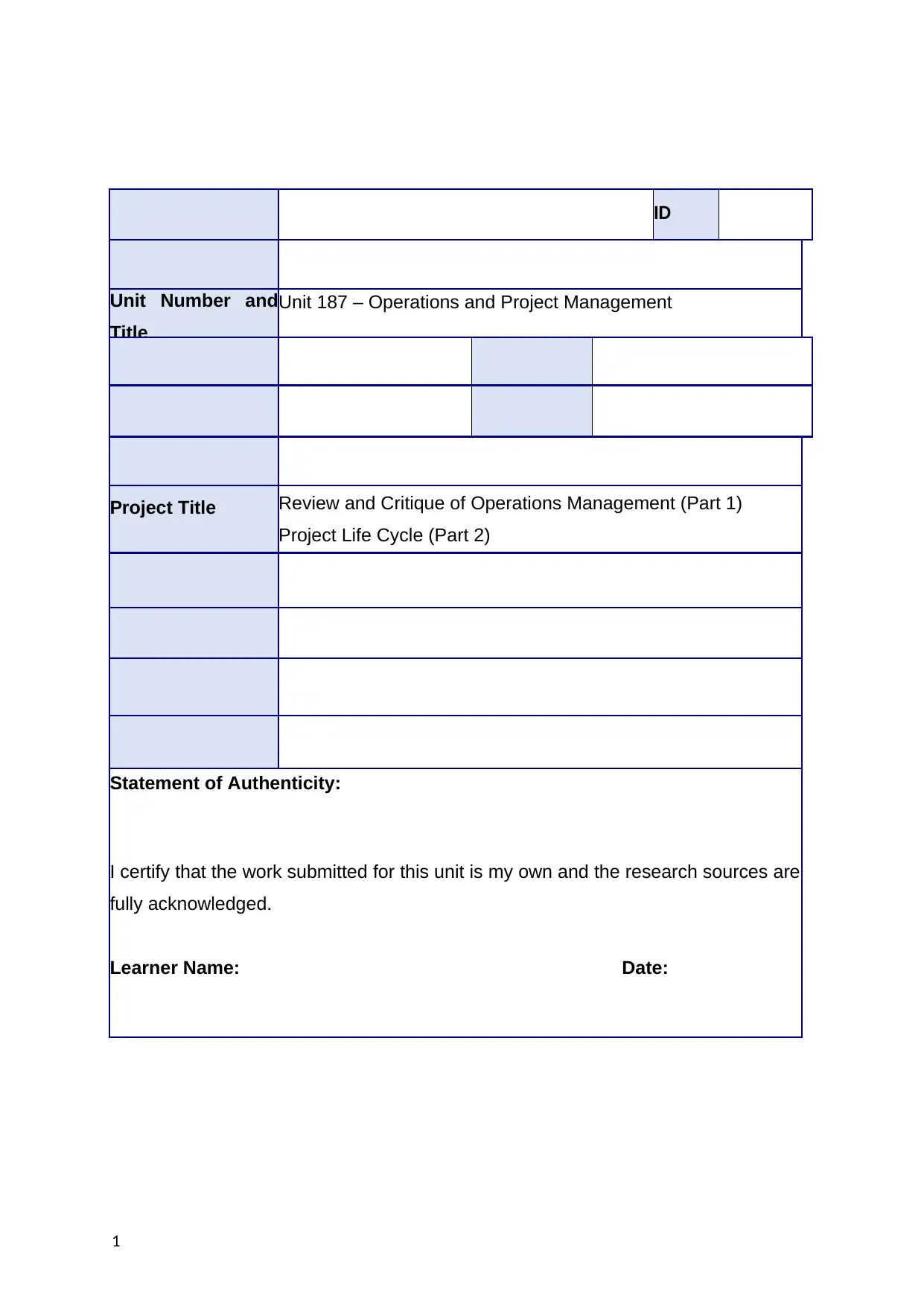
ID
Unit Number and
Title
Unit 187 – Operations and Project Management
Project Title Review and Critique of Operations Management (Part 1)
Project Life Cycle (Part 2)
Statement of Authenticity:
I certify that the work submitted for this unit is my own and the research sources are
fully acknowledged.
Learner Name: Date:
1
Unit Number and
Title
Unit 187 – Operations and Project Management
Project Title Review and Critique of Operations Management (Part 1)
Project Life Cycle (Part 2)
Statement of Authenticity:
I certify that the work submitted for this unit is my own and the research sources are
fully acknowledged.
Learner Name: Date:
1
Paraphrase This Document
Need a fresh take? Get an instant paraphrase of this document with our AI Paraphraser
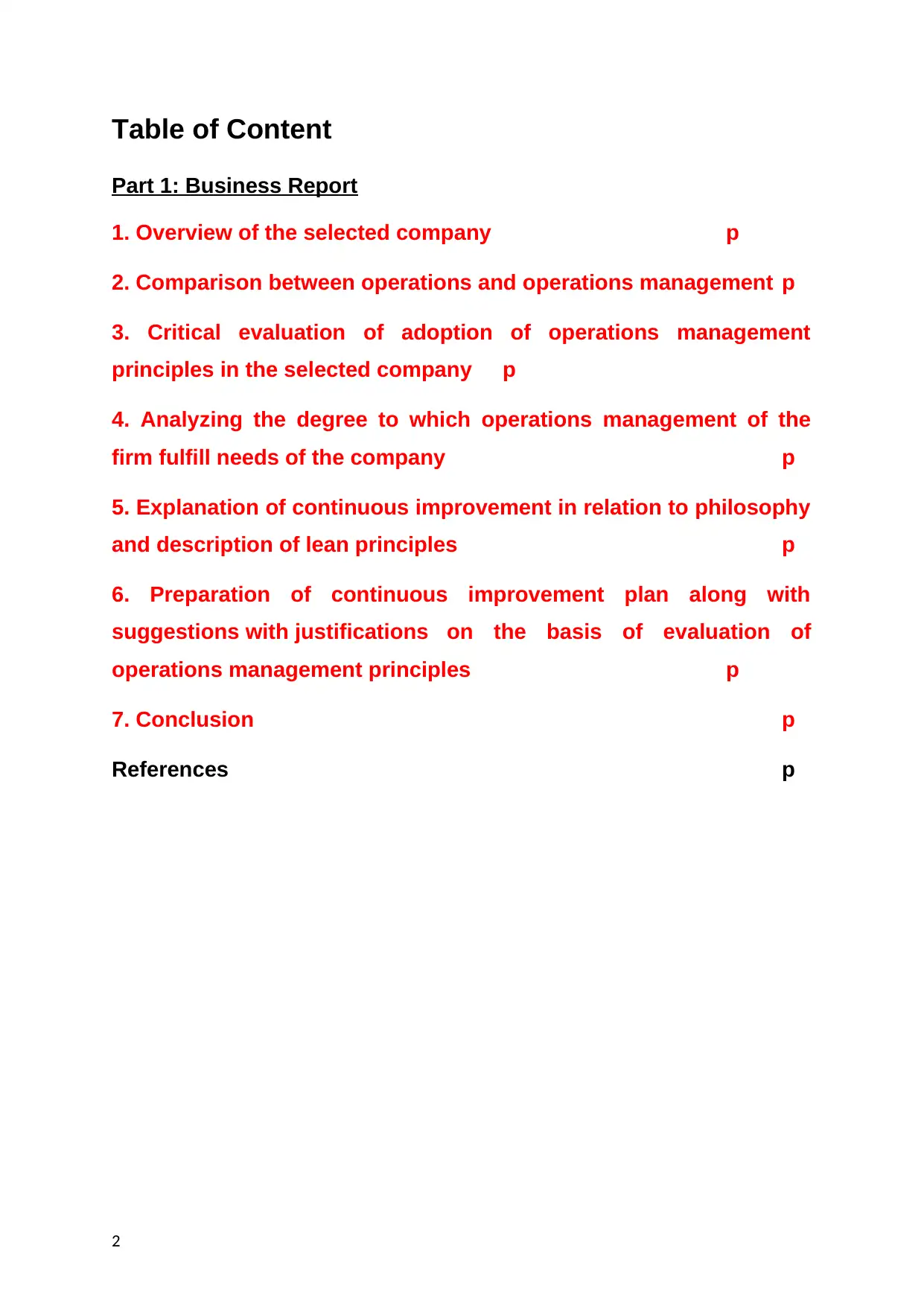
Table of Content
Part 1: Business Report
1. Overview of the selected company p
2. Comparison between operations and operations management p
3. Critical evaluation of adoption of operations management
principles in the selected company p
4. Analyzing the degree to which operations management of the
firm fulfill needs of the company p
5. Explanation of continuous improvement in relation to philosophy
and description of lean principles p
6. Preparation of continuous improvement plan along with
suggestions with justifications on the basis of evaluation of
operations management principles p
7. Conclusion p
References p
2
Part 1: Business Report
1. Overview of the selected company p
2. Comparison between operations and operations management p
3. Critical evaluation of adoption of operations management
principles in the selected company p
4. Analyzing the degree to which operations management of the
firm fulfill needs of the company p
5. Explanation of continuous improvement in relation to philosophy
and description of lean principles p
6. Preparation of continuous improvement plan along with
suggestions with justifications on the basis of evaluation of
operations management principles p
7. Conclusion p
References p
2
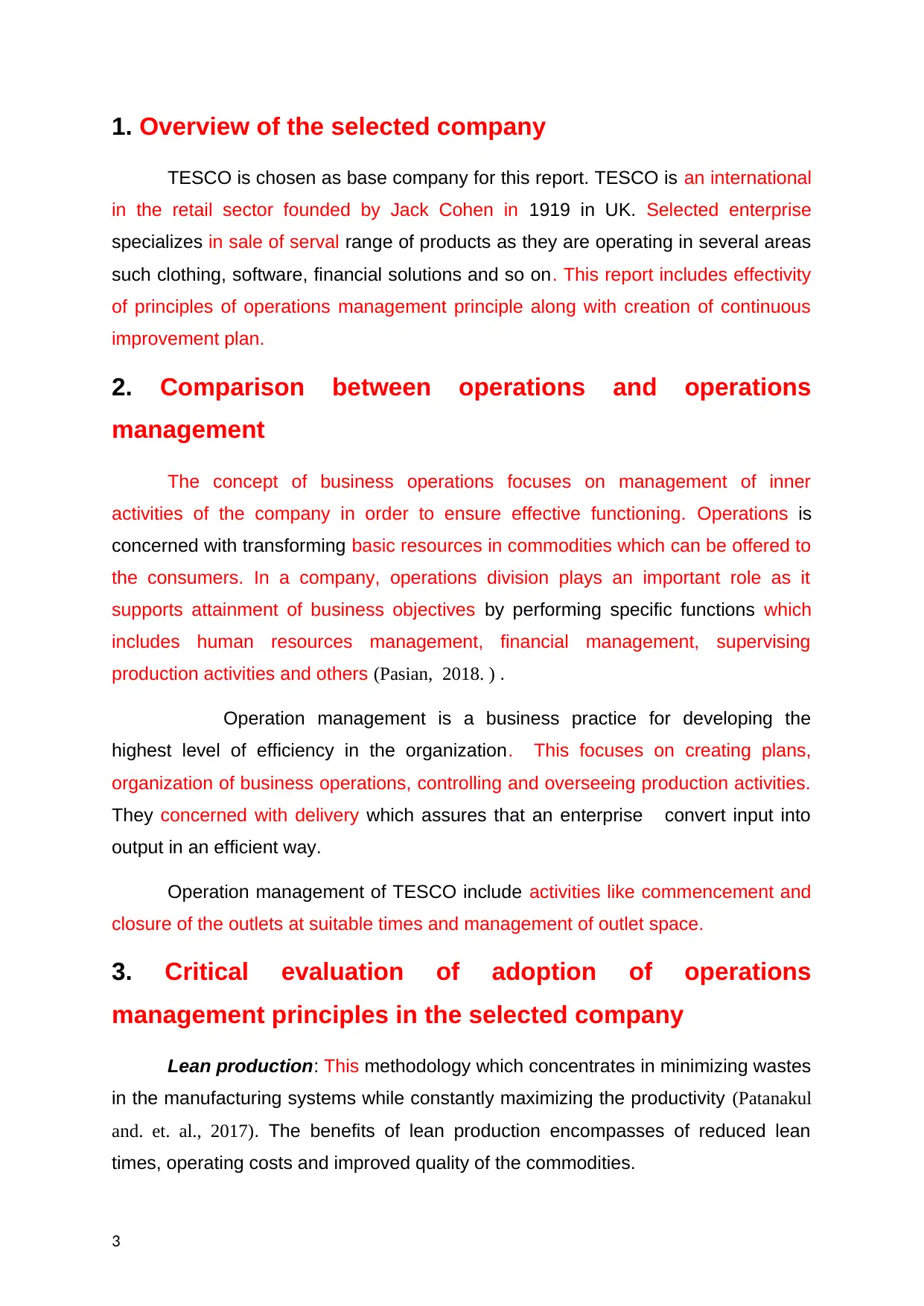
1. Overview of the selected company
TESCO is chosen as base company for this report. TESCO is an international
in the retail sector founded by Jack Cohen in 1919 in UK. Selected enterprise
specializes in sale of serval range of products as they are operating in several areas
such clothing, software, financial solutions and so on. This report includes effectivity
of principles of operations management principle along with creation of continuous
improvement plan.
2. Comparison between operations and operations
management
The concept of business operations focuses on management of inner
activities of the company in order to ensure effective functioning. Operations is
concerned with transforming basic resources in commodities which can be offered to
the consumers. In a company, operations division plays an important role as it
supports attainment of business objectives by performing specific functions which
includes human resources management, financial management, supervising
production activities and others (Pasian, 2018. ) .
Operation management is a business practice for developing the
highest level of efficiency in the organization. This focuses on creating plans,
organization of business operations, controlling and overseeing production activities.
They concerned with delivery which assures that an enterprise convert input into
output in an efficient way.
Operation management of TESCO include activities like commencement and
closure of the outlets at suitable times and management of outlet space.
3. Critical evaluation of adoption of operations
management principles in the selected company
Lean production: This methodology which concentrates in minimizing wastes
in the manufacturing systems while constantly maximizing the productivity (Patanakul
and. et. al., 2017). The benefits of lean production encompasses of reduced lean
times, operating costs and improved quality of the commodities.
3
TESCO is chosen as base company for this report. TESCO is an international
in the retail sector founded by Jack Cohen in 1919 in UK. Selected enterprise
specializes in sale of serval range of products as they are operating in several areas
such clothing, software, financial solutions and so on. This report includes effectivity
of principles of operations management principle along with creation of continuous
improvement plan.
2. Comparison between operations and operations
management
The concept of business operations focuses on management of inner
activities of the company in order to ensure effective functioning. Operations is
concerned with transforming basic resources in commodities which can be offered to
the consumers. In a company, operations division plays an important role as it
supports attainment of business objectives by performing specific functions which
includes human resources management, financial management, supervising
production activities and others (Pasian, 2018. ) .
Operation management is a business practice for developing the
highest level of efficiency in the organization. This focuses on creating plans,
organization of business operations, controlling and overseeing production activities.
They concerned with delivery which assures that an enterprise convert input into
output in an efficient way.
Operation management of TESCO include activities like commencement and
closure of the outlets at suitable times and management of outlet space.
3. Critical evaluation of adoption of operations
management principles in the selected company
Lean production: This methodology which concentrates in minimizing wastes
in the manufacturing systems while constantly maximizing the productivity (Patanakul
and. et. al., 2017). The benefits of lean production encompasses of reduced lean
times, operating costs and improved quality of the commodities.
3
⊘ This is a preview!⊘
Do you want full access?
Subscribe today to unlock all pages.

Trusted by 1+ million students worldwide
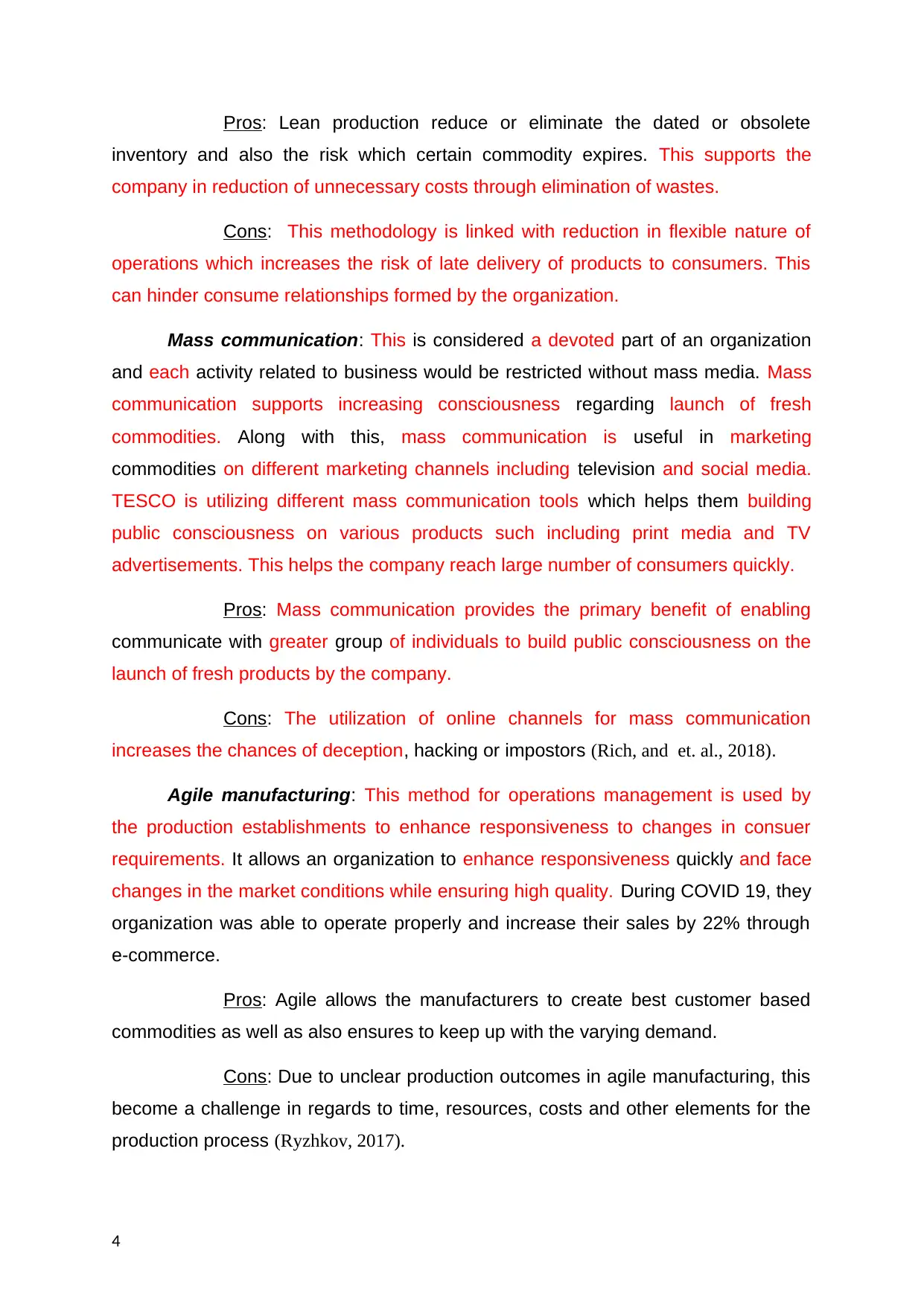
Pros: Lean production reduce or eliminate the dated or obsolete
inventory and also the risk which certain commodity expires. This supports the
company in reduction of unnecessary costs through elimination of wastes.
Cons: This methodology is linked with reduction in flexible nature of
operations which increases the risk of late delivery of products to consumers. This
can hinder consume relationships formed by the organization.
Mass communication: This is considered a devoted part of an organization
and each activity related to business would be restricted without mass media. Mass
communication supports increasing consciousness regarding launch of fresh
commodities. Along with this, mass communication is useful in marketing
commodities on different marketing channels including television and social media.
TESCO is utilizing different mass communication tools which helps them building
public consciousness on various products such including print media and TV
advertisements. This helps the company reach large number of consumers quickly.
Pros: Mass communication provides the primary benefit of enabling
communicate with greater group of individuals to build public consciousness on the
launch of fresh products by the company.
Cons: The utilization of online channels for mass communication
increases the chances of deception, hacking or impostors (Rich, and et. al., 2018).
Agile manufacturing: This method for operations management is used by
the production establishments to enhance responsiveness to changes in consuer
requirements. It allows an organization to enhance responsiveness quickly and face
changes in the market conditions while ensuring high quality. During COVID 19, they
organization was able to operate properly and increase their sales by 22% through
e-commerce.
Pros: Agile allows the manufacturers to create best customer based
commodities as well as also ensures to keep up with the varying demand.
Cons: Due to unclear production outcomes in agile manufacturing, this
become a challenge in regards to time, resources, costs and other elements for the
production process (Ryzhkov, 2017).
4
inventory and also the risk which certain commodity expires. This supports the
company in reduction of unnecessary costs through elimination of wastes.
Cons: This methodology is linked with reduction in flexible nature of
operations which increases the risk of late delivery of products to consumers. This
can hinder consume relationships formed by the organization.
Mass communication: This is considered a devoted part of an organization
and each activity related to business would be restricted without mass media. Mass
communication supports increasing consciousness regarding launch of fresh
commodities. Along with this, mass communication is useful in marketing
commodities on different marketing channels including television and social media.
TESCO is utilizing different mass communication tools which helps them building
public consciousness on various products such including print media and TV
advertisements. This helps the company reach large number of consumers quickly.
Pros: Mass communication provides the primary benefit of enabling
communicate with greater group of individuals to build public consciousness on the
launch of fresh products by the company.
Cons: The utilization of online channels for mass communication
increases the chances of deception, hacking or impostors (Rich, and et. al., 2018).
Agile manufacturing: This method for operations management is used by
the production establishments to enhance responsiveness to changes in consuer
requirements. It allows an organization to enhance responsiveness quickly and face
changes in the market conditions while ensuring high quality. During COVID 19, they
organization was able to operate properly and increase their sales by 22% through
e-commerce.
Pros: Agile allows the manufacturers to create best customer based
commodities as well as also ensures to keep up with the varying demand.
Cons: Due to unclear production outcomes in agile manufacturing, this
become a challenge in regards to time, resources, costs and other elements for the
production process (Ryzhkov, 2017).
4
Paraphrase This Document
Need a fresh take? Get an instant paraphrase of this document with our AI Paraphraser
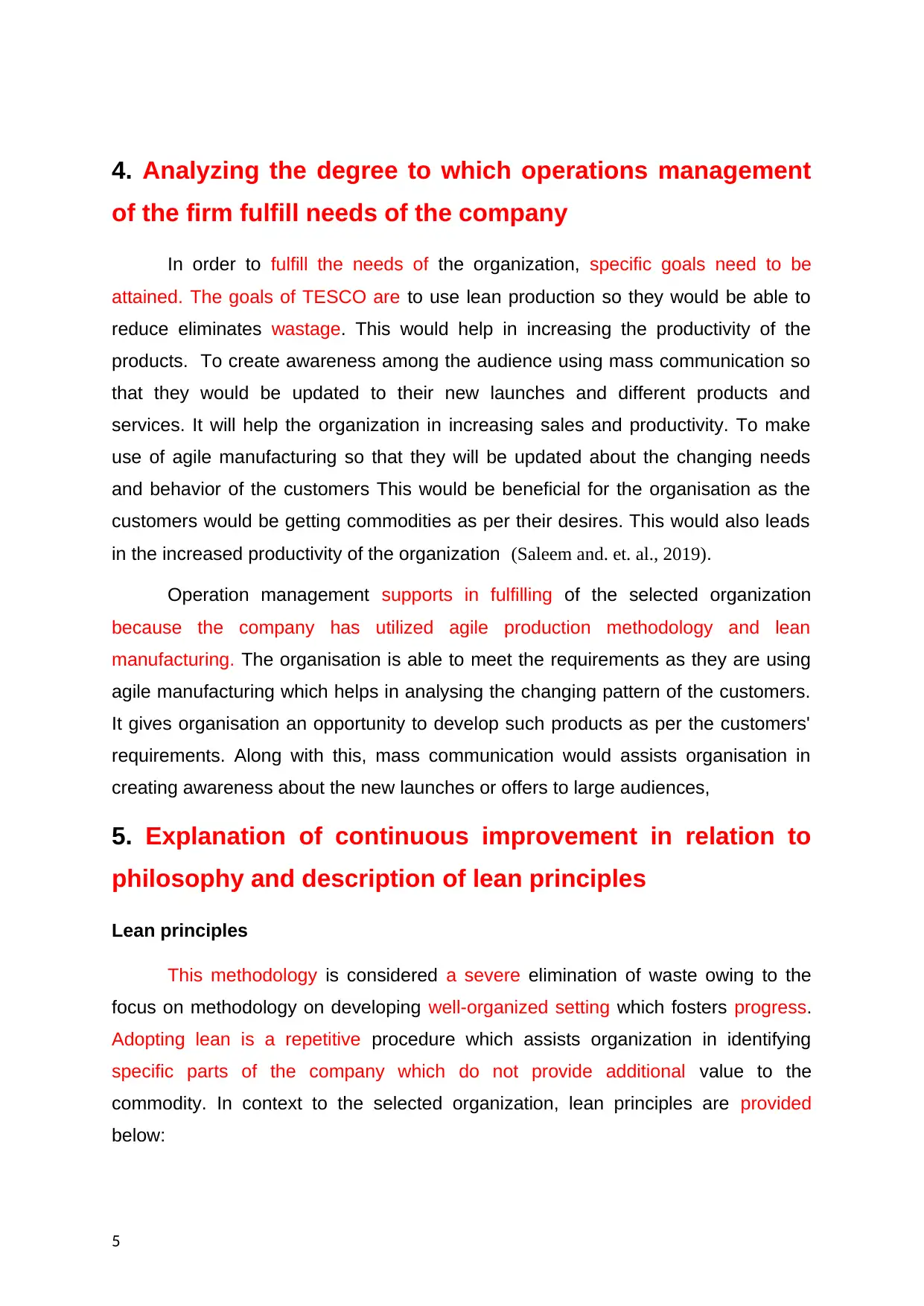
4. Analyzing the degree to which operations management
of the firm fulfill needs of the company
In order to fulfill the needs of the organization, specific goals need to be
attained. The goals of TESCO are to use lean production so they would be able to
reduce eliminates wastage. This would help in increasing the productivity of the
products. To create awareness among the audience using mass communication so
that they would be updated to their new launches and different products and
services. It will help the organization in increasing sales and productivity. To make
use of agile manufacturing so that they will be updated about the changing needs
and behavior of the customers This would be beneficial for the organisation as the
customers would be getting commodities as per their desires. This would also leads
in the increased productivity of the organization (Saleem and. et. al., 2019).
Operation management supports in fulfilling of the selected organization
because the company has utilized agile production methodology and lean
manufacturing. The organisation is able to meet the requirements as they are using
agile manufacturing which helps in analysing the changing pattern of the customers.
It gives organisation an opportunity to develop such products as per the customers'
requirements. Along with this, mass communication would assists organisation in
creating awareness about the new launches or offers to large audiences,
5. Explanation of continuous improvement in relation to
philosophy and description of lean principles
Lean principles
This methodology is considered a severe elimination of waste owing to the
focus on methodology on developing well-organized setting which fosters progress.
Adopting lean is a repetitive procedure which assists organization in identifying
specific parts of the company which do not provide additional value to the
commodity. In context to the selected organization, lean principles are provided
below:
5
of the firm fulfill needs of the company
In order to fulfill the needs of the organization, specific goals need to be
attained. The goals of TESCO are to use lean production so they would be able to
reduce eliminates wastage. This would help in increasing the productivity of the
products. To create awareness among the audience using mass communication so
that they would be updated to their new launches and different products and
services. It will help the organization in increasing sales and productivity. To make
use of agile manufacturing so that they will be updated about the changing needs
and behavior of the customers This would be beneficial for the organisation as the
customers would be getting commodities as per their desires. This would also leads
in the increased productivity of the organization (Saleem and. et. al., 2019).
Operation management supports in fulfilling of the selected organization
because the company has utilized agile production methodology and lean
manufacturing. The organisation is able to meet the requirements as they are using
agile manufacturing which helps in analysing the changing pattern of the customers.
It gives organisation an opportunity to develop such products as per the customers'
requirements. Along with this, mass communication would assists organisation in
creating awareness about the new launches or offers to large audiences,
5. Explanation of continuous improvement in relation to
philosophy and description of lean principles
Lean principles
This methodology is considered a severe elimination of waste owing to the
focus on methodology on developing well-organized setting which fosters progress.
Adopting lean is a repetitive procedure which assists organization in identifying
specific parts of the company which do not provide additional value to the
commodity. In context to the selected organization, lean principles are provided
below:
5
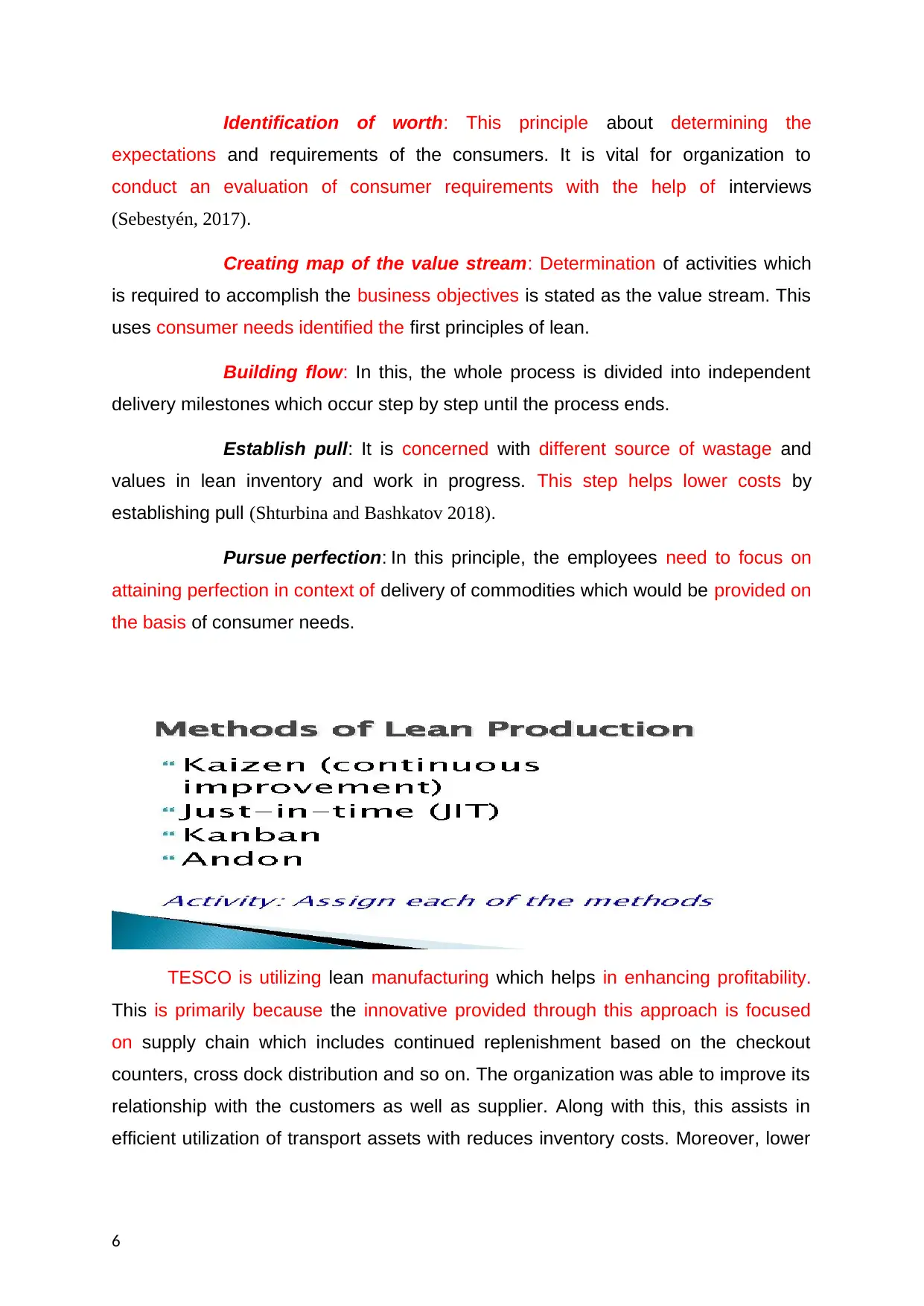
Identification of worth: This principle about determining the
expectations and requirements of the consumers. It is vital for organization to
conduct an evaluation of consumer requirements with the help of interviews
(Sebestyén, 2017).
Creating map of the value stream: Determination of activities which
is required to accomplish the business objectives is stated as the value stream. This
uses consumer needs identified the first principles of lean.
Building flow: In this, the whole process is divided into independent
delivery milestones which occur step by step until the process ends.
Establish pull: It is concerned with different source of wastage and
values in lean inventory and work in progress. This step helps lower costs by
establishing pull (Shturbina and Bashkatov 2018).
Pursue perfection: In this principle, the employees need to focus on
attaining perfection in context of delivery of commodities which would be provided on
the basis of consumer needs.
TESCO is utilizing lean manufacturing which helps in enhancing profitability.
This is primarily because the innovative provided through this approach is focused
on supply chain which includes continued replenishment based on the checkout
counters, cross dock distribution and so on. The organization was able to improve its
relationship with the customers as well as supplier. Along with this, this assists in
efficient utilization of transport assets with reduces inventory costs. Moreover, lower
6
expectations and requirements of the consumers. It is vital for organization to
conduct an evaluation of consumer requirements with the help of interviews
(Sebestyén, 2017).
Creating map of the value stream: Determination of activities which
is required to accomplish the business objectives is stated as the value stream. This
uses consumer needs identified the first principles of lean.
Building flow: In this, the whole process is divided into independent
delivery milestones which occur step by step until the process ends.
Establish pull: It is concerned with different source of wastage and
values in lean inventory and work in progress. This step helps lower costs by
establishing pull (Shturbina and Bashkatov 2018).
Pursue perfection: In this principle, the employees need to focus on
attaining perfection in context of delivery of commodities which would be provided on
the basis of consumer needs.
TESCO is utilizing lean manufacturing which helps in enhancing profitability.
This is primarily because the innovative provided through this approach is focused
on supply chain which includes continued replenishment based on the checkout
counters, cross dock distribution and so on. The organization was able to improve its
relationship with the customers as well as supplier. Along with this, this assists in
efficient utilization of transport assets with reduces inventory costs. Moreover, lower
6
⊘ This is a preview!⊘
Do you want full access?
Subscribe today to unlock all pages.

Trusted by 1+ million students worldwide
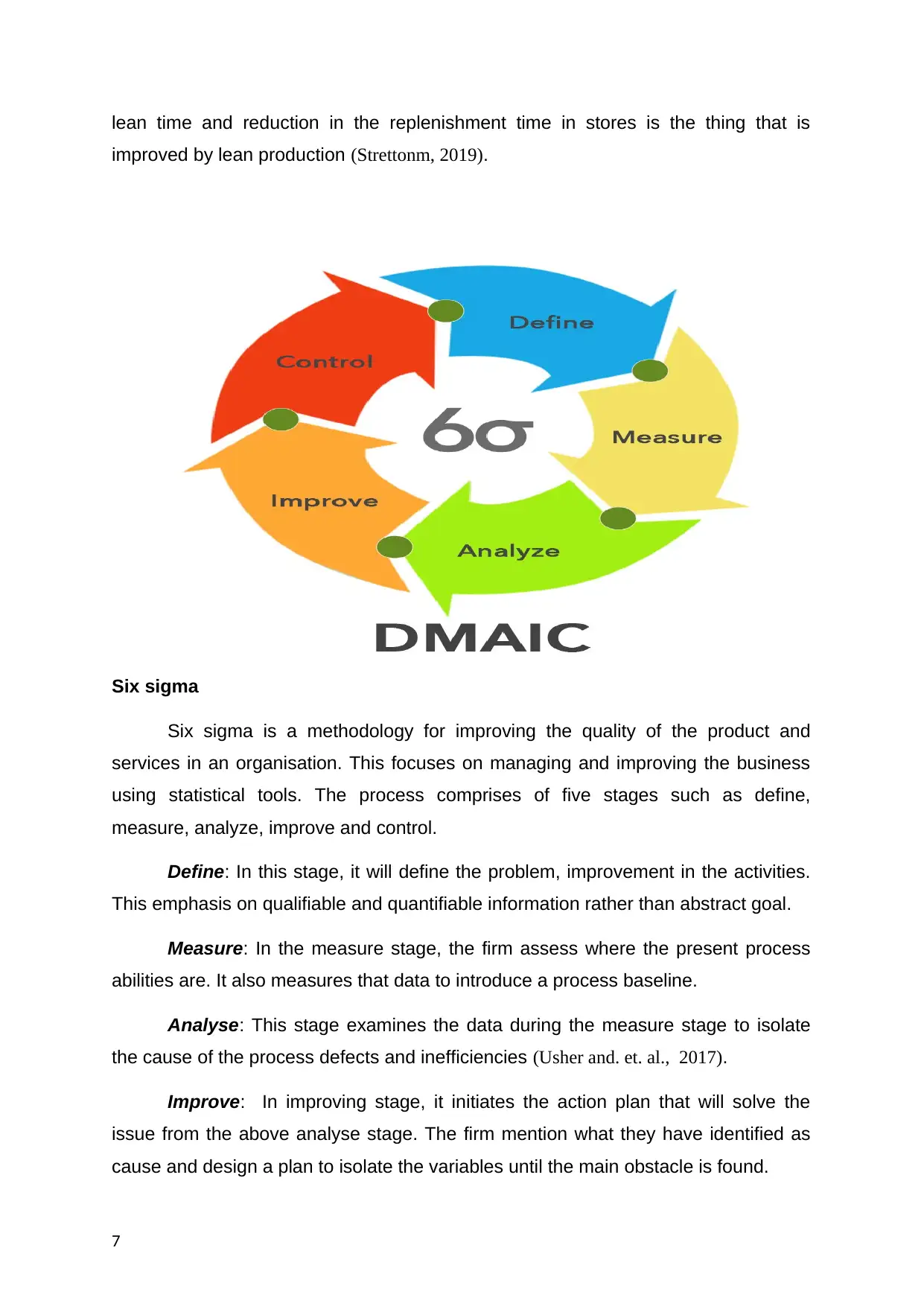
lean time and reduction in the replenishment time in stores is the thing that is
improved by lean production (Strettonm, 2019).
Six sigma
Six sigma is a methodology for improving the quality of the product and
services in an organisation. This focuses on managing and improving the business
using statistical tools. The process comprises of five stages such as define,
measure, analyze, improve and control.
Define: In this stage, it will define the problem, improvement in the activities.
This emphasis on qualifiable and quantifiable information rather than abstract goal.
Measure: In the measure stage, the firm assess where the present process
abilities are. It also measures that data to introduce a process baseline.
Analyse: This stage examines the data during the measure stage to isolate
the cause of the process defects and inefficiencies (Usher and. et. al., 2017).
Improve: In improving stage, it initiates the action plan that will solve the
issue from the above analyse stage. The firm mention what they have identified as
cause and design a plan to isolate the variables until the main obstacle is found.
7
improved by lean production (Strettonm, 2019).
Six sigma
Six sigma is a methodology for improving the quality of the product and
services in an organisation. This focuses on managing and improving the business
using statistical tools. The process comprises of five stages such as define,
measure, analyze, improve and control.
Define: In this stage, it will define the problem, improvement in the activities.
This emphasis on qualifiable and quantifiable information rather than abstract goal.
Measure: In the measure stage, the firm assess where the present process
abilities are. It also measures that data to introduce a process baseline.
Analyse: This stage examines the data during the measure stage to isolate
the cause of the process defects and inefficiencies (Usher and. et. al., 2017).
Improve: In improving stage, it initiates the action plan that will solve the
issue from the above analyse stage. The firm mention what they have identified as
cause and design a plan to isolate the variables until the main obstacle is found.
7
Paraphrase This Document
Need a fresh take? Get an instant paraphrase of this document with our AI Paraphraser
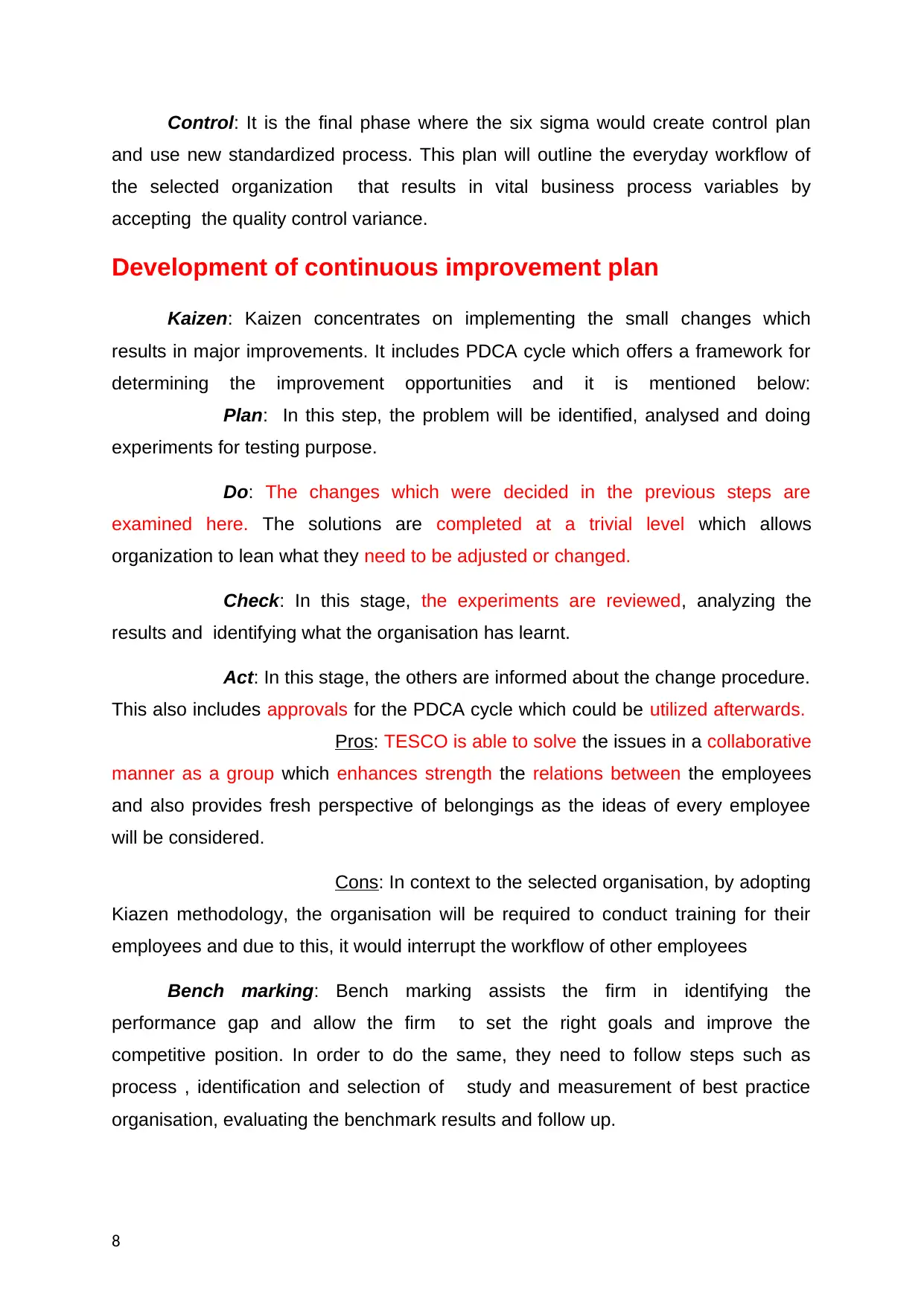
Control: It is the final phase where the six sigma would create control plan
and use new standardized process. This plan will outline the everyday workflow of
the selected organization that results in vital business process variables by
accepting the quality control variance.
Development of continuous improvement plan
Kaizen: Kaizen concentrates on implementing the small changes which
results in major improvements. It includes PDCA cycle which offers a framework for
determining the improvement opportunities and it is mentioned below:
Plan: In this step, the problem will be identified, analysed and doing
experiments for testing purpose.
Do: The changes which were decided in the previous steps are
examined here. The solutions are completed at a trivial level which allows
organization to lean what they need to be adjusted or changed.
Check: In this stage, the experiments are reviewed, analyzing the
results and identifying what the organisation has learnt.
Act: In this stage, the others are informed about the change procedure.
This also includes approvals for the PDCA cycle which could be utilized afterwards.
Pros: TESCO is able to solve the issues in a collaborative
manner as a group which enhances strength the relations between the employees
and also provides fresh perspective of belongings as the ideas of every employee
will be considered.
Cons: In context to the selected organisation, by adopting
Kiazen methodology, the organisation will be required to conduct training for their
employees and due to this, it would interrupt the workflow of other employees
Bench marking: Bench marking assists the firm in identifying the
performance gap and allow the firm to set the right goals and improve the
competitive position. In order to do the same, they need to follow steps such as
process , identification and selection of study and measurement of best practice
organisation, evaluating the benchmark results and follow up.
8
and use new standardized process. This plan will outline the everyday workflow of
the selected organization that results in vital business process variables by
accepting the quality control variance.
Development of continuous improvement plan
Kaizen: Kaizen concentrates on implementing the small changes which
results in major improvements. It includes PDCA cycle which offers a framework for
determining the improvement opportunities and it is mentioned below:
Plan: In this step, the problem will be identified, analysed and doing
experiments for testing purpose.
Do: The changes which were decided in the previous steps are
examined here. The solutions are completed at a trivial level which allows
organization to lean what they need to be adjusted or changed.
Check: In this stage, the experiments are reviewed, analyzing the
results and identifying what the organisation has learnt.
Act: In this stage, the others are informed about the change procedure.
This also includes approvals for the PDCA cycle which could be utilized afterwards.
Pros: TESCO is able to solve the issues in a collaborative
manner as a group which enhances strength the relations between the employees
and also provides fresh perspective of belongings as the ideas of every employee
will be considered.
Cons: In context to the selected organisation, by adopting
Kiazen methodology, the organisation will be required to conduct training for their
employees and due to this, it would interrupt the workflow of other employees
Bench marking: Bench marking assists the firm in identifying the
performance gap and allow the firm to set the right goals and improve the
competitive position. In order to do the same, they need to follow steps such as
process , identification and selection of study and measurement of best practice
organisation, evaluating the benchmark results and follow up.
8
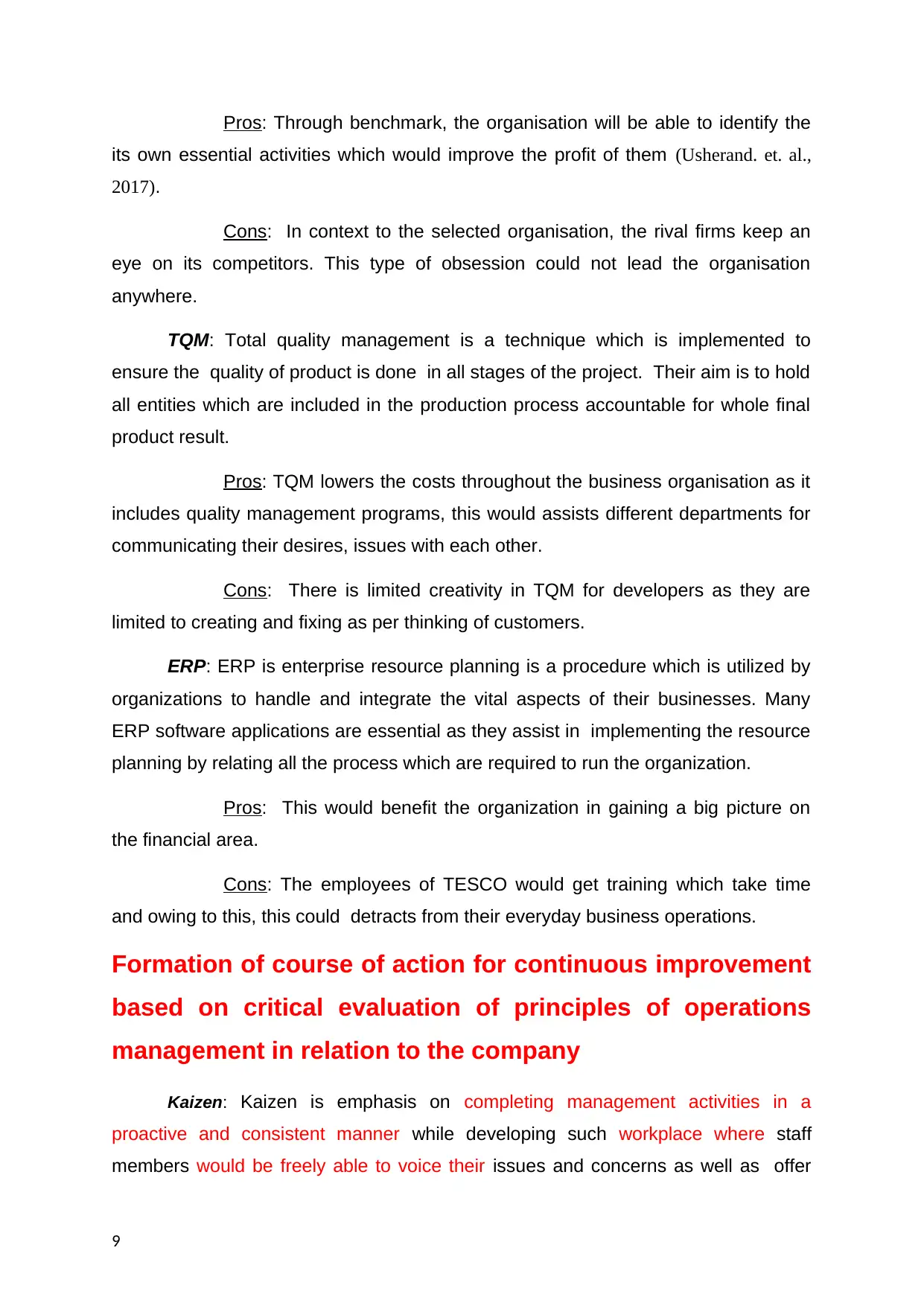
Pros: Through benchmark, the organisation will be able to identify the
its own essential activities which would improve the profit of them (Usherand. et. al.,
2017).
Cons: In context to the selected organisation, the rival firms keep an
eye on its competitors. This type of obsession could not lead the organisation
anywhere.
TQM: Total quality management is a technique which is implemented to
ensure the quality of product is done in all stages of the project. Their aim is to hold
all entities which are included in the production process accountable for whole final
product result.
Pros: TQM lowers the costs throughout the business organisation as it
includes quality management programs, this would assists different departments for
communicating their desires, issues with each other.
Cons: There is limited creativity in TQM for developers as they are
limited to creating and fixing as per thinking of customers.
ERP: ERP is enterprise resource planning is a procedure which is utilized by
organizations to handle and integrate the vital aspects of their businesses. Many
ERP software applications are essential as they assist in implementing the resource
planning by relating all the process which are required to run the organization.
Pros: This would benefit the organization in gaining a big picture on
the financial area.
Cons: The employees of TESCO would get training which take time
and owing to this, this could detracts from their everyday business operations.
Formation of course of action for continuous improvement
based on critical evaluation of principles of operations
management in relation to the company
Kaizen: Kaizen is emphasis on completing management activities in a
proactive and consistent manner while developing such workplace where staff
members would be freely able to voice their issues and concerns as well as offer
9
its own essential activities which would improve the profit of them (Usherand. et. al.,
2017).
Cons: In context to the selected organisation, the rival firms keep an
eye on its competitors. This type of obsession could not lead the organisation
anywhere.
TQM: Total quality management is a technique which is implemented to
ensure the quality of product is done in all stages of the project. Their aim is to hold
all entities which are included in the production process accountable for whole final
product result.
Pros: TQM lowers the costs throughout the business organisation as it
includes quality management programs, this would assists different departments for
communicating their desires, issues with each other.
Cons: There is limited creativity in TQM for developers as they are
limited to creating and fixing as per thinking of customers.
ERP: ERP is enterprise resource planning is a procedure which is utilized by
organizations to handle and integrate the vital aspects of their businesses. Many
ERP software applications are essential as they assist in implementing the resource
planning by relating all the process which are required to run the organization.
Pros: This would benefit the organization in gaining a big picture on
the financial area.
Cons: The employees of TESCO would get training which take time
and owing to this, this could detracts from their everyday business operations.
Formation of course of action for continuous improvement
based on critical evaluation of principles of operations
management in relation to the company
Kaizen: Kaizen is emphasis on completing management activities in a
proactive and consistent manner while developing such workplace where staff
members would be freely able to voice their issues and concerns as well as offer
9
⊘ This is a preview!⊘
Do you want full access?
Subscribe today to unlock all pages.

Trusted by 1+ million students worldwide
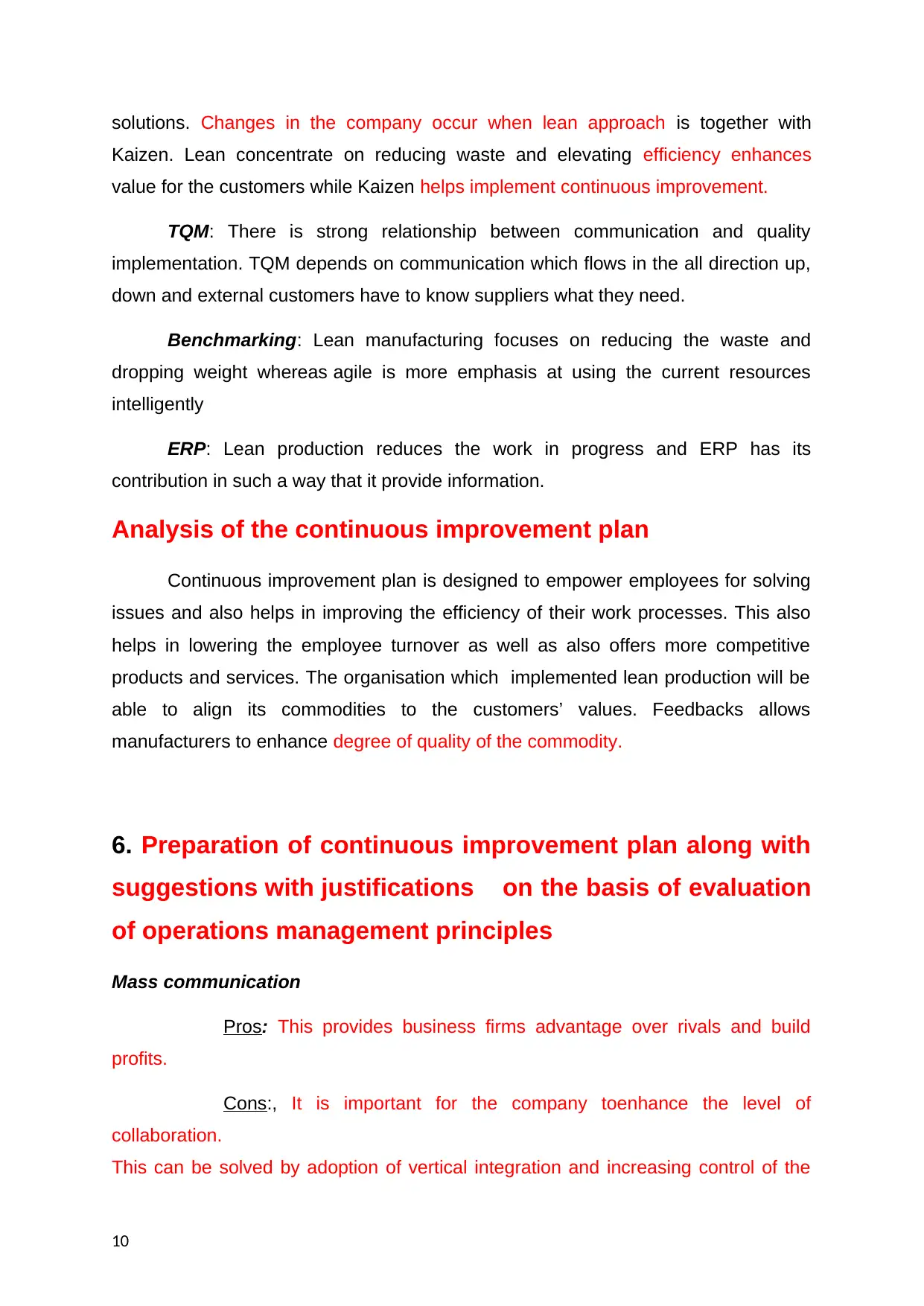
solutions. Changes in the company occur when lean approach is together with
Kaizen. Lean concentrate on reducing waste and elevating efficiency enhances
value for the customers while Kaizen helps implement continuous improvement.
TQM: There is strong relationship between communication and quality
implementation. TQM depends on communication which flows in the all direction up,
down and external customers have to know suppliers what they need.
Benchmarking: Lean manufacturing focuses on reducing the waste and
dropping weight whereas agile is more emphasis at using the current resources
intelligently
ERP: Lean production reduces the work in progress and ERP has its
contribution in such a way that it provide information.
Analysis of the continuous improvement plan
Continuous improvement plan is designed to empower employees for solving
issues and also helps in improving the efficiency of their work processes. This also
helps in lowering the employee turnover as well as also offers more competitive
products and services. The organisation which implemented lean production will be
able to align its commodities to the customers’ values. Feedbacks allows
manufacturers to enhance degree of quality of the commodity.
6. Preparation of continuous improvement plan along with
suggestions with justifications on the basis of evaluation
of operations management principles
Mass communication
Pros: This provides business firms advantage over rivals and build
profits.
Cons:, It is important for the company toenhance the level of
collaboration.
This can be solved by adoption of vertical integration and increasing control of the
10
Kaizen. Lean concentrate on reducing waste and elevating efficiency enhances
value for the customers while Kaizen helps implement continuous improvement.
TQM: There is strong relationship between communication and quality
implementation. TQM depends on communication which flows in the all direction up,
down and external customers have to know suppliers what they need.
Benchmarking: Lean manufacturing focuses on reducing the waste and
dropping weight whereas agile is more emphasis at using the current resources
intelligently
ERP: Lean production reduces the work in progress and ERP has its
contribution in such a way that it provide information.
Analysis of the continuous improvement plan
Continuous improvement plan is designed to empower employees for solving
issues and also helps in improving the efficiency of their work processes. This also
helps in lowering the employee turnover as well as also offers more competitive
products and services. The organisation which implemented lean production will be
able to align its commodities to the customers’ values. Feedbacks allows
manufacturers to enhance degree of quality of the commodity.
6. Preparation of continuous improvement plan along with
suggestions with justifications on the basis of evaluation
of operations management principles
Mass communication
Pros: This provides business firms advantage over rivals and build
profits.
Cons:, It is important for the company toenhance the level of
collaboration.
This can be solved by adoption of vertical integration and increasing control of the
10
Paraphrase This Document
Need a fresh take? Get an instant paraphrase of this document with our AI Paraphraser
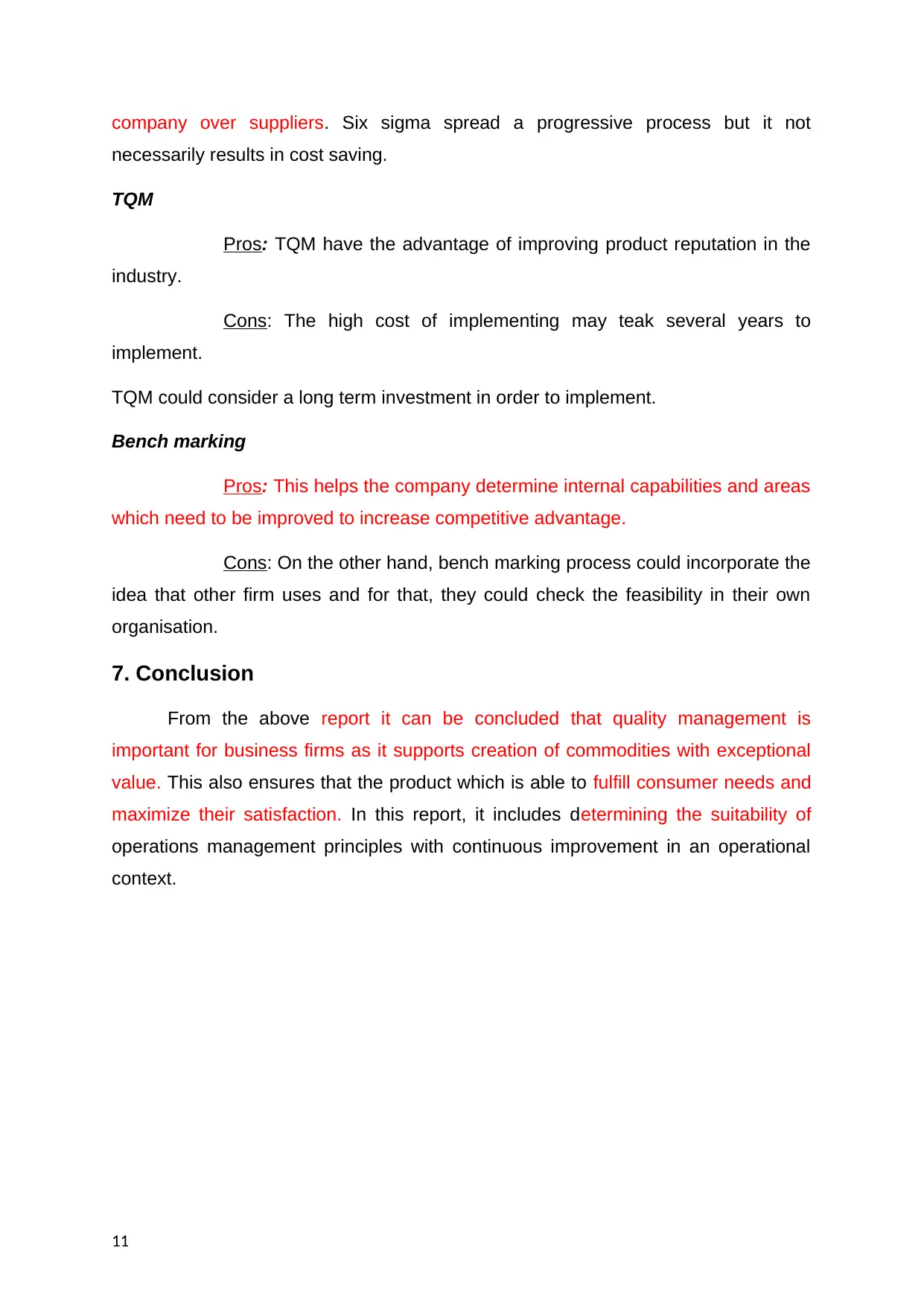
company over suppliers. Six sigma spread a progressive process but it not
necessarily results in cost saving.
TQM
Pros: TQM have the advantage of improving product reputation in the
industry.
Cons: The high cost of implementing may teak several years to
implement.
TQM could consider a long term investment in order to implement.
Bench marking
Pros: This helps the company determine internal capabilities and areas
which need to be improved to increase competitive advantage.
Cons: On the other hand, bench marking process could incorporate the
idea that other firm uses and for that, they could check the feasibility in their own
organisation.
7. Conclusion
From the above report it can be concluded that quality management is
important for business firms as it supports creation of commodities with exceptional
value. This also ensures that the product which is able to fulfill consumer needs and
maximize their satisfaction. In this report, it includes determining the suitability of
operations management principles with continuous improvement in an operational
context.
11
necessarily results in cost saving.
TQM
Pros: TQM have the advantage of improving product reputation in the
industry.
Cons: The high cost of implementing may teak several years to
implement.
TQM could consider a long term investment in order to implement.
Bench marking
Pros: This helps the company determine internal capabilities and areas
which need to be improved to increase competitive advantage.
Cons: On the other hand, bench marking process could incorporate the
idea that other firm uses and for that, they could check the feasibility in their own
organisation.
7. Conclusion
From the above report it can be concluded that quality management is
important for business firms as it supports creation of commodities with exceptional
value. This also ensures that the product which is able to fulfill consumer needs and
maximize their satisfaction. In this report, it includes determining the suitability of
operations management principles with continuous improvement in an operational
context.
11
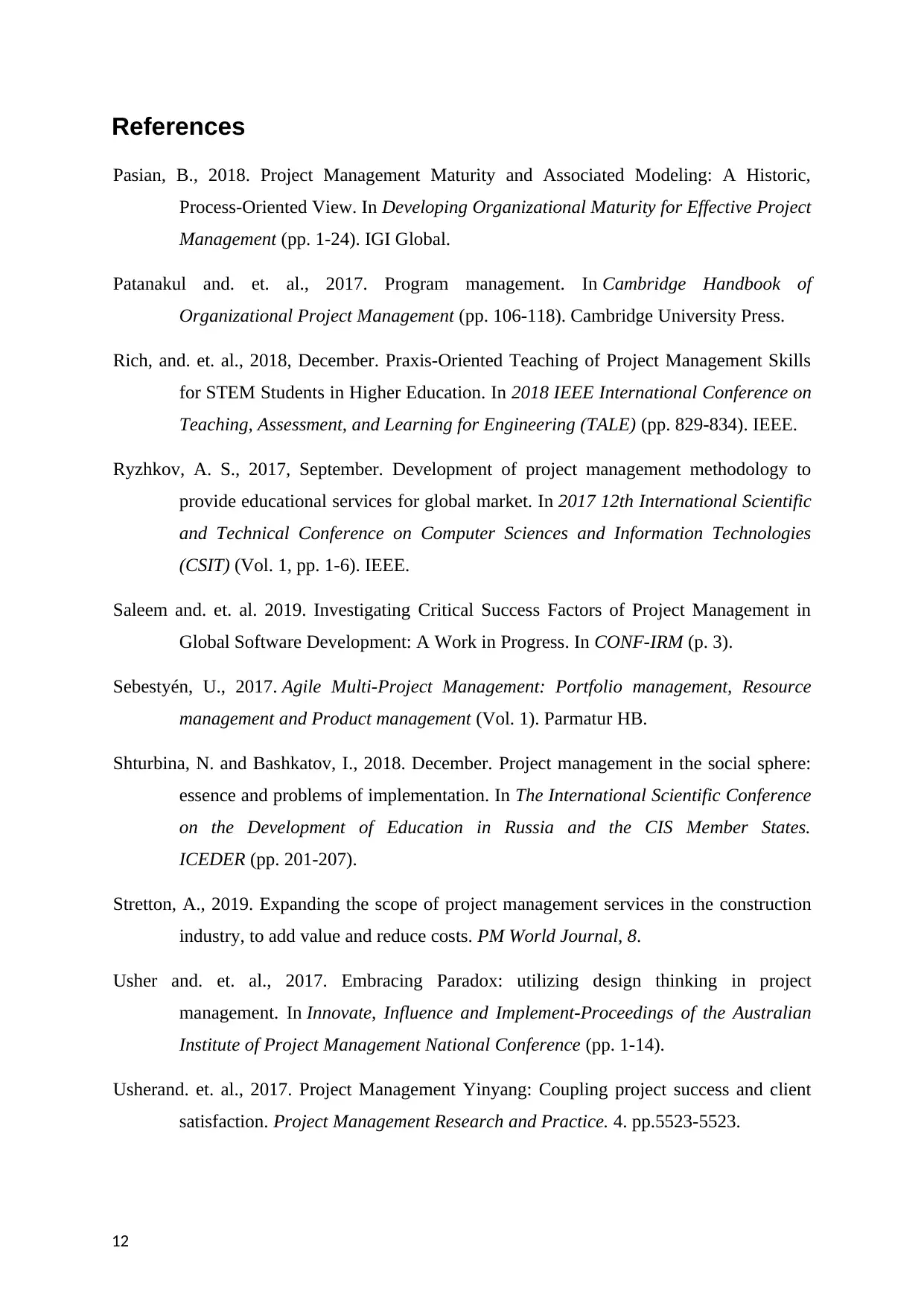
References
Pasian, B., 2018. Project Management Maturity and Associated Modeling: A Historic,
Process-Oriented View. In Developing Organizational Maturity for Effective Project
Management (pp. 1-24). IGI Global.
Patanakul and. et. al., 2017. Program management. In Cambridge Handbook of
Organizational Project Management (pp. 106-118). Cambridge University Press.
Rich, and. et. al., 2018, December. Praxis-Oriented Teaching of Project Management Skills
for STEM Students in Higher Education. In 2018 IEEE International Conference on
Teaching, Assessment, and Learning for Engineering (TALE) (pp. 829-834). IEEE.
Ryzhkov, A. S., 2017, September. Development of project management methodology to
provide educational services for global market. In 2017 12th International Scientific
and Technical Conference on Computer Sciences and Information Technologies
(CSIT) (Vol. 1, pp. 1-6). IEEE.
Saleem and. et. al. 2019. Investigating Critical Success Factors of Project Management in
Global Software Development: A Work in Progress. In CONF-IRM (p. 3).
Sebestyén, U., 2017. Agile Multi-Project Management: Portfolio management, Resource
management and Product management (Vol. 1). Parmatur HB.
Shturbina, N. and Bashkatov, I., 2018. December. Project management in the social sphere:
essence and problems of implementation. In The International Scientific Conference
on the Development of Education in Russia and the CIS Member States.
ICEDER (pp. 201-207).
Stretton, A., 2019. Expanding the scope of project management services in the construction
industry, to add value and reduce costs. PM World Journal, 8.
Usher and. et. al., 2017. Embracing Paradox: utilizing design thinking in project
management. In Innovate, Influence and Implement-Proceedings of the Australian
Institute of Project Management National Conference (pp. 1-14).
Usherand. et. al., 2017. Project Management Yinyang: Coupling project success and client
satisfaction. Project Management Research and Practice. 4. pp.5523-5523.
12
Pasian, B., 2018. Project Management Maturity and Associated Modeling: A Historic,
Process-Oriented View. In Developing Organizational Maturity for Effective Project
Management (pp. 1-24). IGI Global.
Patanakul and. et. al., 2017. Program management. In Cambridge Handbook of
Organizational Project Management (pp. 106-118). Cambridge University Press.
Rich, and. et. al., 2018, December. Praxis-Oriented Teaching of Project Management Skills
for STEM Students in Higher Education. In 2018 IEEE International Conference on
Teaching, Assessment, and Learning for Engineering (TALE) (pp. 829-834). IEEE.
Ryzhkov, A. S., 2017, September. Development of project management methodology to
provide educational services for global market. In 2017 12th International Scientific
and Technical Conference on Computer Sciences and Information Technologies
(CSIT) (Vol. 1, pp. 1-6). IEEE.
Saleem and. et. al. 2019. Investigating Critical Success Factors of Project Management in
Global Software Development: A Work in Progress. In CONF-IRM (p. 3).
Sebestyén, U., 2017. Agile Multi-Project Management: Portfolio management, Resource
management and Product management (Vol. 1). Parmatur HB.
Shturbina, N. and Bashkatov, I., 2018. December. Project management in the social sphere:
essence and problems of implementation. In The International Scientific Conference
on the Development of Education in Russia and the CIS Member States.
ICEDER (pp. 201-207).
Stretton, A., 2019. Expanding the scope of project management services in the construction
industry, to add value and reduce costs. PM World Journal, 8.
Usher and. et. al., 2017. Embracing Paradox: utilizing design thinking in project
management. In Innovate, Influence and Implement-Proceedings of the Australian
Institute of Project Management National Conference (pp. 1-14).
Usherand. et. al., 2017. Project Management Yinyang: Coupling project success and client
satisfaction. Project Management Research and Practice. 4. pp.5523-5523.
12
⊘ This is a preview!⊘
Do you want full access?
Subscribe today to unlock all pages.

Trusted by 1+ million students worldwide
1 out of 30
Related Documents
Your All-in-One AI-Powered Toolkit for Academic Success.
+13062052269
info@desklib.com
Available 24*7 on WhatsApp / Email
![[object Object]](/_next/static/media/star-bottom.7253800d.svg)
Unlock your academic potential
Copyright © 2020–2025 A2Z Services. All Rights Reserved. Developed and managed by ZUCOL.
